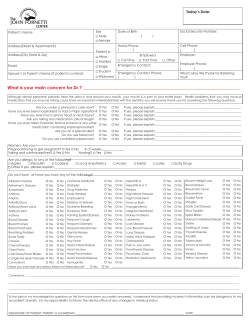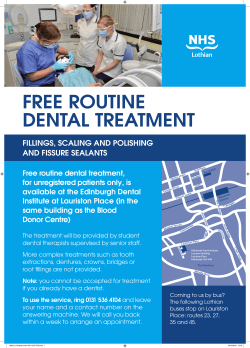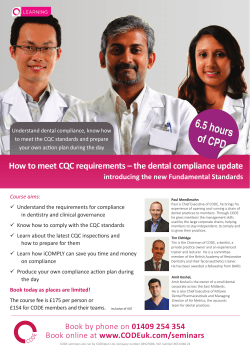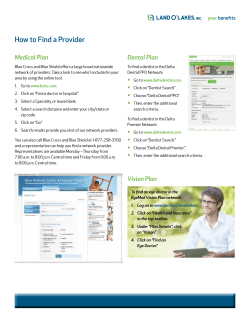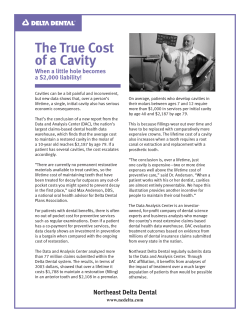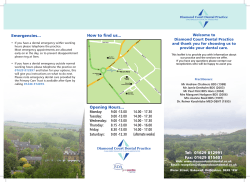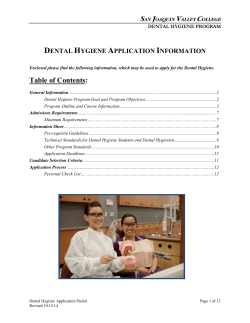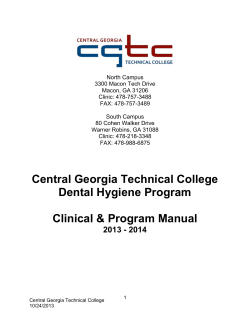
COVER SHEET Administrative - Master Syllabus
Administrative - Master Syllabus COVER SHEET Purpose: It is the intention of this Administrative-Master Syllabus to provide a general description of the course, outline the required elements of the course and to lay the foundation for course assessment for the improvement of student learning, as specified by the faculty of Wharton County Junior College, regardless of who teaches the course, the timeframe by which it is instructed, or the instructional method by which the course is delivered. It is not intended to restrict the manner by which an individual faculty member teaches the course but to be an administrative tool to aid in the improvement of instruction. Course Title – Contemporary Dental Hygiene Care I Course Prefix and Number – DHYG 2201 Department – Dental Hygiene Division – Allied Health Course Type: (check one) Academic General Education Course (from ACGM – but not in WCJC Core) Academic WCJC Core Course X WECM course (This course is a Special Topics or Unique Needs Course: Y or N X Semester Credit Hours # : Lecture hours# : Lab/other hours # 2:2:0 List Lab/ Other Hours Lab Hours Equated Pay hours for course - 2 Clinical Hours Course Catalog Description - Dental hygiene care for the medically or dentally compromised patient including supplemental instrumentation techniques. Practicum Hours Prerequisites/Co requisites - DHYG 1227, 1261, 1304, 1307, 1319, and 1339 with grade of “C” or higher. Other (list) Prepared by Dale G. Hahn Date 9-6-2011 Reviewed by department head Carol Derkowski Date9/19/11 Accuracy verified by Division Chair Carol Derkowski Date9/19/11 Approved by Dean of Vocational Instruction or Vice President of Instruction Stephanie Dees Date 12-15-2011 Administrative-Master Syllabus revised April 2011 Page 1 of 5 Administrative - Master Syllabus I. Topical Outline – Each offering of this course must include the following topics (be sure to include information regarding lab, practicum, clinical or other non-lecture instruction): I. Course Information A. Course Outcomes B. Course Schedule C. Course Evaluation D. Methods of Instruction II. Review of Instrumentation A. Principles of Instrumentation B. Sharpening Techniques C. Management of Broken Instrument Tip III. Nonsurgical Periodontal Instrumentation A. Dental Hygiene Care Plan for Instrumentation B. Overall Appointment Systems C. Scaling with Manual Instruments 1. Principles of Instrumentation D. Use of Ultrasonics in Non-Surgical Periodontal Therapy 1. Mode of Action 2. Types (Define, Compare, Contrast types of) a. sonic b. piezoelectric c. magnetostrictive 3. Purposes and Uses 4. Contraindications (medical and dental) 5. Procedure 6. Instrument Tip Design 7. Sterilization Procedure IV. Scaling and Root Planing Instrumentation A. Rationale B. Technique C. Benefits to the Tissue V. Dentinal Hypersensitivity A. Definition B. Types of Pain Stimuli C. Etiology of Dentin Hypersensitivity 1. Contributing Factors 2. Desensitizing Agents 3. Dental Hygiene Care D. Dentin Structure E. Management Strategies VI. Dental Anxiety and Pain Management A. Definitions B. Sign/Symptoms C. Management Options Administrative-Master Syllabus revised April 2011 Page 2 of 5 VII. VIII. IX. X. XI. XII. XIII. Nonsurgical Periodontal Therapy: Supplemental Care Procedures A. Patient Needs B. Supplemental Care Procedures C. Advanced Instrumentation D. Antimicrobial Treatment E. Professional Subgingival Irrigation 1. Patient Selection 2. Application F. Local Delivery of Antimicrobials 1. Types 2. Methods of Delivery 3. Applications for Clinic and Contraindications 4. Home Care Respiratory Diseases A. Types B. Signs/symptoms C. Treatment D. Dental Management Cardiovascular Diseases A. Define Major Types B. Signs/Symptoms of each Type C. Dental Considerations for Treatment D. Cardiac Arrhythmias E. Oral Implications with Anticoagulant Therapy Blood Disorders A. Oral Findings Suggestive of Blood Disorders B. Normal Blood C. Red Blood Cell Disorders 1. Types 2. Signs/Symptoms 3. Dental Hygiene Care D. White Blood Cell Disorders 1. Types 2. Signs/symptoms 3. Oral Manifestations 4. Dental Hygiene Care E. Coagulation Disorders 1. Types 2. Dental Hygiene Care Sexually Transmitted Diseases A. Types of Diseases B. Pathogens (agents) C. Mode of Transmission D. Description – Signs/Symptoms E. Dental Management F. Treatment Chemotherapeutic Agents A. Actions B. Substantivity C. Indications for Use D. Agents Available Dental Caries Management by Risk Assessment A. Define Disease of Dental Caries B. Disease Indicators and Risk Factors C. Caries Management by Risk Assessment Administrative-Master Syllabus revised April 2011 Page 3 of 5 XIV. Geriatrics A. Changes and Disorders 1. Osteoporosis – definition 2. Alzheimer’s disease B. Oral Conditions of the Aged C. Dental Hygiene Care 1. Clinical facilities 2. Patient assessment 3. Plaque Control 4. Diet & Nutrition II. Course Learning Outcomes Course Learning Outcome Assess various patient needs; formulate a treatment plan for the medically and dentally compromised patient; and describe supplemental instrumentation techniques. Method of Assessment Written examinations, lab exercises, clinical application, case studies III. Required Text(s), Optional Text(s) and/or Materials to be Supplied by Student. 1. Wilkins, Esther M., Clinical Practice of the Dental Hygienist, 10th Edition, Lippincott Williams & Wilkins, 2009. 2. Thomson, Evelyn, Case Studies in Dental Hygiene, 2nd Edition, Prentice Hall, 2009. 3. Nield-Gehrig, Jill S., Fundamentals of Periodontal Instrumentation & Advanced Root Instrumentation, 6th Edition, Lippincott Williams & Wilkins, 2008. 4. Wynn, Richard, Timothy Meiller and Harold Crossley, Drug Information Handbook for Dentistry, 16th Edition, Lexi-Comp Inc., 2010. 5. Derkowski, C., Mayfield, S., Hahn, D., Bode, B., Novosad, G., Bay, F., Wharton County Junior College Dental Hygiene Clinic Manual, May 2011. 6. Darby, Michele, Mosby’s Comprehensive Review in Dental Hygiene, 6th edition, Mosby Elsevier, 2006. 7. Prajer, Renee and Gwen Grosso, DH Notes: Dental Hygienist’s Chairside Pocket Guide, F. A. Davis Co., 2011. IV. Suggested Course Maximum - 28 V. List any specific spatial or physical requirements beyond a typical classroom required to teach the course. Dental hygiene clinic with dental units and sterilization area. VI. Course Requirements/Grading System – Describe any course specific requirements such as research papers or reading assignments and the generalized grading format for the course A = 100-93, B = 92-84, C = 83-75, D = 74-67, F = 66 and below A minimum grade of 75 (C) is necessary to pass DHYG 2201 (and any other DHYG –designated course). Administrative-Master Syllabus revised April 2011 Page 4 of 5 EVALUATION: Examinations (4) Class Participation Final Examination 50% 10% 40% EVALUATION OF LATE ASSIGNMENTS: Assignments must be turned in during class on the due date. Failure to do so for any reason will result in a 5-point grade reduction per calendar day and after 3 calendar days will receive a maximum of only a 75% for a grade. VII. Curriculum Checklist - Academic General Education Course (from ACGM – but not in WCJC Core) No additional documentation needed - Academic WCJC Core Course Attach the Core Curriculum Checklist, including the following: Basic Intellectual Competencies Perspectives Exemplary Educational Objectives X - WECM Courses If needed, revise the Program SCANS Matrix & Competencies Checklist. Administrative-Master Syllabus revised April 2011 Page 5 of 5
© Copyright 2025


